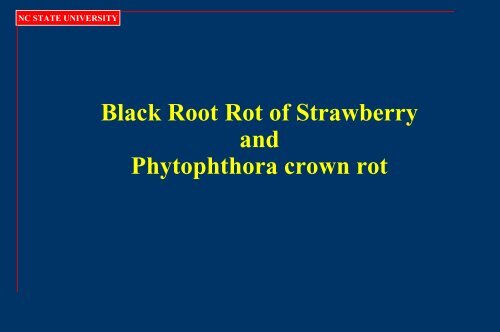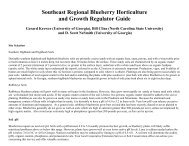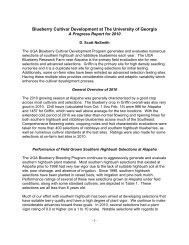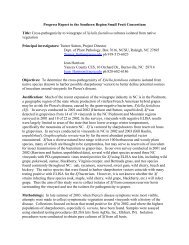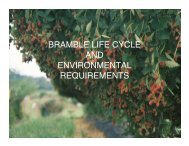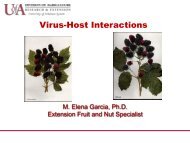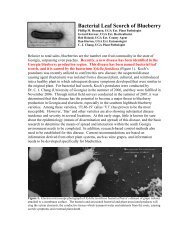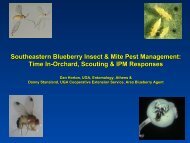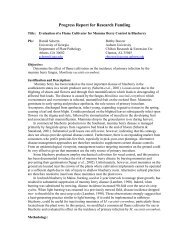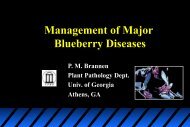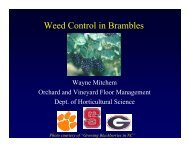Black Root Rot of Strawberry and Phytophthora Crown Rot
Black Root Rot of Strawberry and Phytophthora Crown Rot
Black Root Rot of Strawberry and Phytophthora Crown Rot
- No tags were found...
You also want an ePaper? Increase the reach of your titles
YUMPU automatically turns print PDFs into web optimized ePapers that Google loves.
NC STATE UNIVERSITY<strong>Black</strong> <strong>Root</strong> <strong>Rot</strong> <strong>of</strong> <strong>Strawberry</strong><strong>and</strong><strong>Phytophthora</strong> crown rot
ABCD<strong>Strawberry</strong> healthy roots (A) as compared with those <strong>of</strong> <strong>Black</strong><strong>Root</strong> <strong>Rot</strong> (B). Close up <strong>of</strong> diseased root (C,D). Observe fungal mycelia in D.
ProcedureRHIZOCTONIA SPP.,FUSARIUM SPP.OTHER FUNGIALKALINE WATER AGAR (AWA)PDA 30PYTHIUM SPP.OTHER FUNGICMACORN MEAL AGAR + ANTIBIOTICS(PARP)GRASS -LEAF-WATER
ASAVA,TSSPythiumGroup “F”A T TAP. ultimumOOgP. irregulareP. spinosumAnamorph stage (A), Sporangium (S), vesicle (V) <strong>and</strong> teleomorph (T) ,Antheridium(A), Oogonium(Og), <strong>and</strong> Oospore(O) <strong>of</strong> Pythium spp.
ABCFL90 AG-GDVOL116 AG-IPLY176 AG-APLY158 AG4 - HGIIIFig. 3 . Colony morphology <strong>of</strong> R. fragariae = A, B, C, <strong>and</strong> R. solani = D in PDA 30
Pathogens to Control• Rhizoctonia fragariae : AG-G, AG-A, AG-I• Pythium irregulare, Pythium spinosum,Pythium artotrogus, Pythium HS• Fusarium solani <strong>and</strong> Fusarium oxysporum
Table 1. Distribution <strong>of</strong> organisms isolated from strawberries affected with<strong>Black</strong> root rot disease in North Carolina. Year 1998FUNGI LOCALITIESFLETCHER VOLLMER PLYMOUTH CLAYTON TOTALRhizoctonia spp. 50 15 9 2 76R. fragariae 30 15 6 2 53A 11 7 3 21I 3 3G 10 10unknown 9 5 2 2 18R. solani AG4-HGIII 1Rhizoctonia sp. 20 3 23Pythium spp. 12 9 21 47 89P. artotrogus 4 1 5P. irregulare 1 6 23 30P. paroec<strong>and</strong>rum 1 1P. ultimum 1 1Pythium “F” 3 4 7Pythium “HS” 2 2Pythium sp. 10 10 23 43Fusarium spp. 7 4 13 9 33F. oxysporum 1 2 3F. solani 2 6 1 9Fusarium sp. 4 2 7 8 21OTHERS 10 7 8 21 46Alternaria sp. 2 2Aspergillus sp. 1 2 3Cephalosporium sp 2 3 5Cylindrocarpon sp. 1 1Cylindrosporium sp. 1 1Epiccocum sp. 3 3Mucor sp. 7 2 1 6 16Penicillium sp. 1 3 7 11Trichoderma sp. 3 1 4TOTAL OF ISOLATES 244Abad, Louws,Grabowski,Fern<strong>and</strong>ez
<strong>Phytophthora</strong> <strong>Crown</strong> <strong>Rot</strong>:
NC STATE UNIVERSITYTomato Diseases
Tomato DiseaseResistanceAvoidanceCulturalpracticesFumigateChemicalOtherVerticillium race 1Verticillium wilt race 2Southern bacterial wiltFusarium race 1Fusarium wilt race 3Southern stem blight<strong>Root</strong> knot nematodes<strong>Phytophthora</strong>Pith necrosisPythium root rot*?******* *** * ** ** *** **
PRIMARY SOILBORNE DISEASESVerticillium wilt race 2
Southern bacterial wilt
Fusarium wilt race 3
Southern Stem Blight
DAMPING OFF
PEPPER PHYTOPHTHORA CROWN & ROOT ROT
SYMPTOMS: FOLIAR BLIGHT/FRUIT ROT
SYMPTOMS: PROCESSING/FRESH


